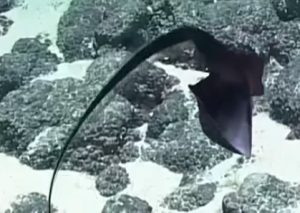Podcast: Play in new window | Download (Duration: 17:10 — 17.1MB)
Subscribe: | More
This week we’re going to learn about all sorts of animals first described by Georg Wilhelm Steller in the mid-18th century and named after him, from the common Steller’s jay to the mysterious Steller’s sea ape.
Steller’s jay. It looks like someone photoshopped a frowny line over its eye:
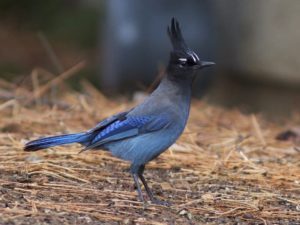

A male Steller’s eider in breeding plumage, looking spiffy:

Steller’s sea eagle will MESS YOU UP:
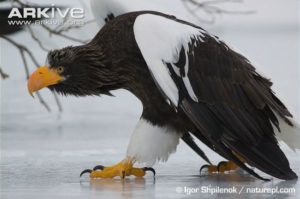
Steller’s sea lions. Looks like the cover of their latest album:
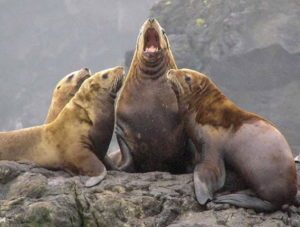
A drawing of a Steller’s sea cow, one of the only drawings that was probably made from an actual animal before it went extinct:

An alive dugong, just to show you what Steller’s sea cow probably looked like, only bigger and fatter because it lived in colder water:
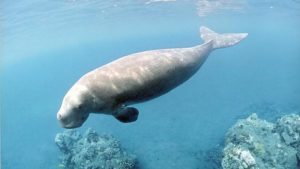
A Northern fur seal not taking any of your crap:
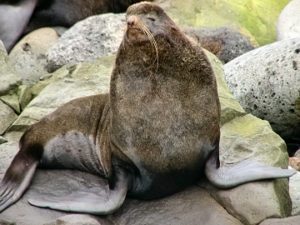
Baby Northern fur seal, just because it’s so cute:
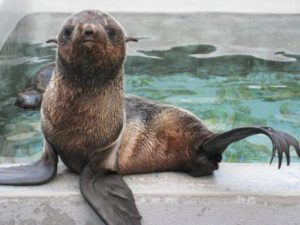
A shih-tzu. Look at those whiskers! Also, adorable topknot:

Show transcript:
Welcome to Strange Animals Podcast. I’m your host, Kate Shaw.
This week we’re going to learn about animals named after Georg Wilhelm Steller. Steller was a German botanist and zoologist who lived in the 18th century. In 1740 he was part of an expedition to the Bering Sea between Siberia’s Kamchatka Peninsula, which you may remember from our mystery bears episode, and Alaska. On the way back from an unscheduled trip to Alaska after they got lost, they were shipwrecked on what is now called Bering Island, where half the crew died of scurvy, and the other half managed to build a boat from the wreck of their ship and sailed it back to Kamchatka. During the several years of this expedition, Steller took careful notes on the animals and plants he encountered.
A number of animals are named after Steller. We’ll look at a bunch of those today. Four are still around, one is extinct, and two… are mysteries.
Let’s start with the birds. Steller’s jay is closely related to the blue jay. The bottom half of the bird looks a lot like a blue jay, blue with black banding on the wings and tail, but with blue underneath instead of white. The top half of the bird looks like a completely different bird, gray with a darker head, white or blue streaks on its face, and a tall floofy crest. It lives in western North America as far north as Alaska, and a bluer version also lives in Central America. It likes forests although like blue jays, it lives around people comfortably and eats pretty much anything, from acorns, seeds, and berries to bugs, small animals, and the eggs and babies of other birds.
Next, Steller’s eider is a type of sea duck that lives off the coasts of Alaska and eastern Siberia. The hen ducks are brown and black like the females of most duck species, but the drake is a lot more interesting to look at. His tail is black, wings are iridescent purply-black laced with white, his breast is cinnamon brown with a black spot on the sides, and his head is white with a black eye ring, a dark green tuft of feathers on the back of his head, and a black throat band. That is one flashy duck. Of course, that’s just during spring and early summer when the males are trying to attract mates. The rest of the year, males look a lot more like females. The term for the opposite of breeding plumage is eclipse plumage.
Steller’s eider dives for its food, mostly crustaceans, clams and mussels, and insects. In the winter, it gathers in huge flocks, and all the ducks in the flock will dive and surface at the same time, creating a huge splash and spray of water. It likes tidal flats, bays, and shallow lagoons, and builds its nest on the edge of ponds.
Steller’s sea eagle is closely related to the bald eagle. It’s a big, stocky bird that’s dark brown with white leg feathers and tail, and white on the shoulders of its wings. It has a heavy yellow bill and huge yellow talons. It lives off the coast of northeastern Asia most of the year, but nests around eastern Russia and on the Kamchatka Peninsula. It mostly eats fish, especially salmon, although it also eats a lot of water birds like gulls and ducks, small mammals, and carrion. Its wingspan is as much as 8 feet across, or 2.5 meters, but there are reports of some birds with wingspans over nine feet across, or 2.8 meters. That’s not much bigger than a bald eagle’s wingspan, but Steller’s sea eagle is much heavier and larger-bodied than the bald eagle. Steller’s sea eagle lives up to the bald eagle’s reputation of being kind of a jerk, though, because it steals food from other Steller’s sea eagles.
Both Steller’s eider and Steller’s sea eagle are threatened by habitat loss. Fortunately, Steller’s jay is doing just fine.
There’s another bird named after Steller that has never been definitively identified, Steller’s sea-raven. During the winter he spent shipwrecked on Bering Island, Steller wrote in his journal about a bird he called a white sea-raven. He didn’t say much about it, just that it was new to him and that it only landed on cliffs along the island’s coast, so he couldn’t get a close look at it. No one knows what bird he was talking about.
A lot of people have made suggestions, of course. One researcher thinks it might be a type of cormorant, since the word for cormorant in German means sea-raven, and in fact that’s what the word cormorant means in the original Latin too—corvus marinus. Cormorants are black birds with usually small white markings, so the cormorant Steller saw might be a white or mostly white species that is now extinct, or he might have seen an albino bird flying around. Then again, the bird might have been something else entirely. Since we don’t have more to go on than this brief description of a white sea-raven that likes ocean-facing cliffs, it’s hard to know what to look for.
Now let’s move on to mammals. Steller’s sea lion is a giant pinniped, the word for members of the seal family. It lives along the coasts of Russia and Alaska as far south as central California. Females grow to about ten feet long, or 3 meters, and males are a little longer and much heavier. Males have thick manes around the neck, which is why it’s called a sea lion. It mostly eats fish and sometimes swims up rivers to feed on salmon and trout. Commercial fishermen used to kill Steller’s sea lions, because clearly no one but humans should be allowed to catch fish, and that and overfishing led to a steep decline in sea lion numbers in the late 20th century. Fortunately, though, after it was listed as a protected species its numbers started to recover.
Steller’s sea cow was not so lucky. It was a sirenian, related to dugongs and manatees. Sirenians evolved around 50 million years ago and share a common ancestor with elephants. Their front flippers have toenails that look like elephant toenails, which is neat. They’re fully aquatic like whales, have a tail instead of hind legs like seals, and like both they’re mammals that breathe air. They live in shallow water and graze on aquatic plants. Occasionally they do eat a jellyfish, but who hasn’t accidentally eaten a jellyfish, right? The sirenians living today grow to around 13 feet long at most, or 4 meters, but Steller’s sea cow was more than twice that length, up to 30 feet long, or 9 meters.
Steller’s sea cow was a type of dugong, and had a whale-like notched tail instead of a rounded tail like a manatee’s. Instead of teeth, it had chewing plates made of keratin that it used to chomp lots and lots of kelp and other plants. Its hide was thick with a thick layer of blubber underneath to keep it warm in the cold water. It had a long upper lip covered in bristles that helped it grab plants. Its forelegs were flipper-like and small.
Like the mysterious sea-raven, Steller discovered the sea cow while he was shipwrecked on Bering Island in 1741. It lived there and around some of the other islands in the Bering Sea, although fossil and sub-fossil remains have been found that indicate it used to be much more widespread. Unfortunately, once it was discovered by Europeans, it was hunted to extinction within 30 years of its discovery, killed for its oil-rich blubber and for food. But Steller’s sea cows have occasionally been spotted after that, although no one has provided actual proof. Many of the sightings may have been of hornless female narwhals, which live in the area and are about the same color and shape as the Steller’s sea-cow when seen from the surface. But in 1962, some whalers spotted six animals in shallow water off the coast of Kamchatka, and whalers can probably be relied upon to recognize a whale when they see it. These animals looked like dugongs. In 1976, a sea-cow carcass reportedly washed up on shore not that far from where the whalers’ sighting had taken place. Some workers at a nearby salmon factory went out to look at it and described it as more like a dugong than a whale, but no one thought to keep the body. After that there were a couple of expeditions to look for surviving Steller’s sea-cows, but while none were found, the coast of Kamchatka and its numerous islands are rugged and hard to explore.
The last animal we’ll talk about is the real mystery, called Steller’s sea ape. He only saw it once off the Shumagin Islands in Alaska on August 10, 1741, but he did watch it for more than two hours and took careful notes. I’ll quote part of his description.
“It was about two ells in length; the head was like a dog’s head, the ears pointed and erect, and on the upper and lower lips, on both sides, whiskers hung down which made it look almost like a Chinaman The eyes were large; the body was longish, round and fat, tapering gradually towards the tail. The skin was covered thickly with hair, gray on the back, reddish white on the belly, but in the water it appeared entirely reddish and cow-colored. The tail was divided into two fins, of which the upper, as in the case of sharks, was twice as large as the lower. Nothing struck me more surprising than the fact that neither forefeet as in the marine amphibians nor, in their stead, fins were to be seen… For over two hours it swam around our ship, looking, as with admiration, first at the one and then at the other of us. At times it came so near to the ship that it could have been touched with a pole, but as soon as anybody stirred it moved away a little further. It could raise itself one-third of its length out of the water exactly like a man, and sometimes it remained in this position for several minutes. After it had observed us for about half an hour, it shot like an arrow under our vessel and came up again on the other side; shortly after, it dived again and reappeared in the old place; and in this way it dived perhaps thirty times.”
Two ells would be somewhere around five feet long, maybe a bit more, or just over 1.5 meters.
This description sounds a lot like a seal of some kind, but all seals have forelimbs. One suggestion is that it was a young Northern fur seal, and that either Steller missed seeing its forelimbs or it was an individual born without them. I’m not sure why the suggestion is that it was a young seal, though. Baby Northern fur seals are black at birth and lighten to brown as they grow, with older males having some gray patches. All appear black in the water, not reddish. Adult females only grow to about 4 ½ feet long, or 1.4 meters, and males about seven feet long, or 2.1 meters, so at five feet long Steller’s animal was already a fully grown female or a nearly full-grown male. Young and female Northern fur seals don’t have the long whiskers Steller describes, although males do—but only when full grown.
So while it’s possible Steller’s sea ape was a small male Northern fur seal with no front flippers or flippers that Steller inexplicably didn’t see, there is one other issue. Steller would have known perfectly well what a Northern fur seal looked like. They’re threatened now due to overhunting and habitat loss, but in the mid-18th century they were plentiful throughout the Bering Sea.
So either Steller saw a Northern fur seal that was so malformed that Steller didn’t recognize it, or he described a different animal. Or, as deep-sea ecologist Andrew Thaler suggests, it was a hoax.
Here’s the situation: Steller and the Danish captain of the ship St. Peter, Vitus Bering, did not get along. The expedition was primarily for charting and exploring the region, not describing new animals, and Bering considered Steller primarily the ship’s physician. When the ship got lost from the rest of the expedition and ended up off the coast of Alaska, Steller had to beg Bering to let him explore this new land. He only got ten hours to do so. And when the crew was stricken with scurvy, Bering refused to allow Steller to treat the crew. I don’t know why he didn’t think the ship’s physician shouldn’t be allowed to do his job. This was before people understood what vitamins were, and while many cures for scurvy were available, no one knew why they worked. When people don’t know how things work, sometimes they’re suspicious of them.
We have Steller’s journals so we know how he described Bering. It wasn’t flattering. Steller’s sighting of the sea ape was only about six weeks after his ten-hour shore leave, and the description of the animal was similar in many ways to his description of Bering. Three months later the ship wrecked and the crew was marooned for eight months. Steller spent the time turning his notes into a book. Bering spent the time dying of scurvy. Steller didn’t include the sea ape in his book.
Thaler points out that Steller didn’t just name his mystery animal a sea-ape, he named it the Danish sea ape, Simnia marina danica. Bering was Danish, the only Dane on the ship in fact.
I have no doubt that Steller was poking fun at Bering in the name, but I’m hesitant to say he made the whole sighting up. For one thing, the details not only point to a real animal, they aren’t malicious or even humorous. He described the sea ape playing with some kelp, swimming back and forth under the ship, things like that.
I think Steller sighted a real animal and took notes, probably because he was so bored he would have taken detailed notes on anything. Maybe he knew he was watching a Northern fur seal and amused himself by comparing it to Bering. Maybe he didn’t know what the animal was but some aspects of it reminded him of Bering. Maybe he left it out of his book because he knew it was a caricature. Maybe he left it out of his book because he didn’t have enough information to include it. Maybe he meant to add it later, when he hopefully would sight more of the animals. I don’t know.
What I do know, though, is that someone else saw a Steller’s sea ape in 1965.
In June of 1965, a British man named Miles Smeeton, which was apparently his real name, was sailing his yacht near the Aleutian Islands when he, his wife, his daughter, and a friend all saw a strange animal they couldn’t identify. It was around five feet long with reddish-yellow fur, a dog-like head, and long whiskers like a shih-tzu. It dived underwater when the ship got near. No one saw any limbs and they were all convinced it wasn’t a seal or a sea otter.
So who knows? Maybe there’s a limbless mammal swimming around in the frigid waters of the Bering Sea, just waiting to be discovered.
You can find Strange Animals Podcast online at strangeanimalspodcast.com. We’re on Twitter at strangebeasties and have a facebook page at facebook.com/strangeanimalspodcast. If you have questions, comments, or suggestions for future episodes, email us at strangeanimalspodcast@gmail.com. If you like the podcast and want to help us out, leave us a rating and review on Apple Podcasts or whatever platform you listen on. We also have a Patreon if you’d like to support us that way.
Thanks for listening!


